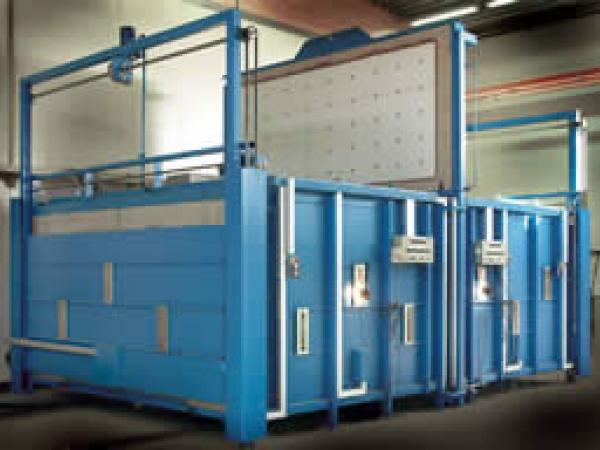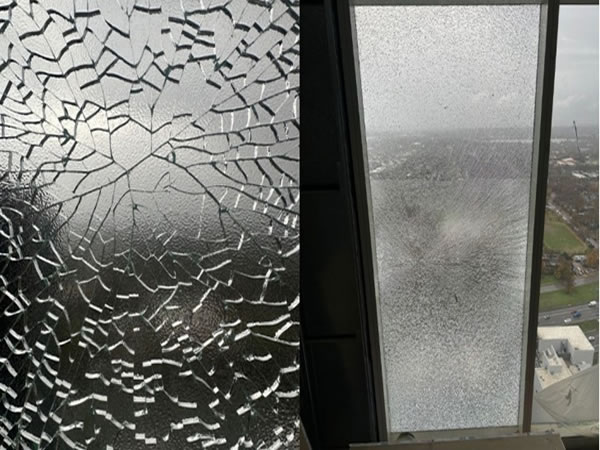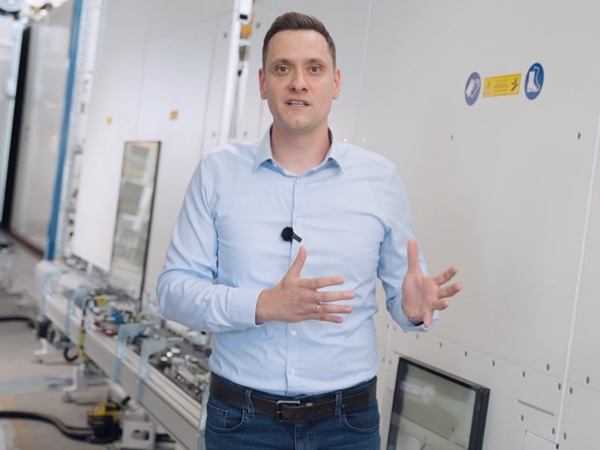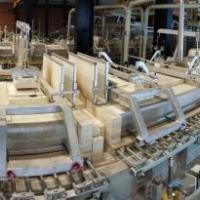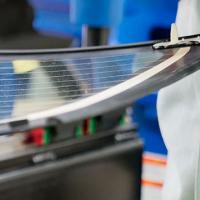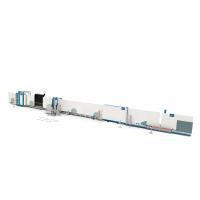Its success has been based on the inexpensive price of a new machine combined with its versatile usage; a concept that has brought the glass tempering process, giving considerable added value to the end product, within the reach of small and medium-sized companies. In principle it is possible to temper on the same machine automotive and architectural glass, furniture glass and industrial glass etc.
The industry has for a long time looked for similar developments in bent tempered glass. And this has happened for long series of bent tempered vehicle glass. The same is true for glass used by industry; display cabinets, domestic appliances etc are mainly made with flexible, powerful horizontal tempering furnaces.
But architectural glass clearly lags behind these other sectors, even though excellent equipment has been developed for the production of even large items of bent glass. This article looks at production technology for bent tempered architectural glass today and at the structure of the markets. It also considers the reasons why bent architectural glass has yet to make a real breakthrough, and has a look at future trends.
Usage determines the bending technology to be used
The most common applications where bent tempered glass is used in buildings can be divided into the following categories:
- façade glass, overhead glass, glass malls
- interior architecture (hand rails, glass partitions, etc.)
- modular structures (e.g. shower cabinets, display windows etc.)
Glass for facades and interior architecture is quite different from that used in shower enclosures for example. Façade and interior architectural glass is usually thick (6-19 mm), mainly has a cylindrical shape, is large (up to 2200*3500 mm), has high optical requirements and is produced in small series. The glass used in shower enclosures is usually 4-6 mm thick and in sizes less than 1500*2400 mm; optical quality is not a key issue and the glass is produced in large series. These differing requirements require different production technology.
No universal machine or concept exists for bending and tempering. The application of the bent glass as well as its properties determine the technology to be used. Equipment for bending and tempering architectural glass can be roughly divided into the following categories, according to their operating principle and structure:
a) Vertical Bending and Tempering Systems
The conventional method in which the upper edge of the glass is held by tongs. The glass is heated in a furnace to the required temperature and then taken out of the furnace to the bending section, where the glass is pressed between two moulds to obtain the required shape. Despite the marks from the tongs, this method is still widely used for architectural glass and for furniture, shop fixtures and short series of vehicle glass (side doors and windshields for tractors, harvesters etc), since it is economical even for short production runs.
b) Horizontal Roller Hearth Furnaces
A new technology is utilising a flat tempering furnace concept. A special bending section has been added between the heating oven and the chiller. The shape can be obtained either by gravity or by pressing between two moulds. Gravity benders can be further divided into two categories: mouldless systems for cylindrical bending and bending in one direction, and mould systems for spherical bending. All these types are widely used in the production of automotive glass in long series. In other areas roller hearth systems are also mainly used in long series production, for shop fixtures, shower doors, domestic appliances etc.
c) Horizontal Bending and Tempering Furnaces
This is another new technology, that is based on a system that bends glass inside the furnace. The glass is heated and bent in a bending oven and then taken to the chiller for tempering and cooling. Gravity bending on a mould or a special tooling system is used to give the shape. This system is mainly used for large products and in short and medium runs, since it is flexible and economical for the purpose. Bending the glass inside the furnace eliminates the need for overheating, so the optical quality is very high. This system is mainly used for architectural glass, for facades, skylights, handrails, revolving doors etc.
Most bent architectural glass is still made today with vertical tempering machines. The vertical machine is inexpensive to purchase. The process has weaknesses, however, and for that reason these machines will in future be replaced by new horizontal tempering machines. The vertical furnace has high mould costs and the process leaves tong marks from on the top edge of the glass, so the glass cannot be used in structures without frames. Furthermore, the overheating needed because the glass cools down during bending, reduces the optical quality of the glass.
Companies are increasingly changing to horizontal tempering machines. For glass to be used in frame-less structures this is the only possible technology, since it leaves no tong marks. The horizontal roller hearth process bends the glass in a separate section after the heating oven, so this also requires overheating, which considerably weakens the optical quality of the end product.
However, bending outside the oven makes it possible to use a wide range of adjustable moulds, which reduces mould costs. The roller hearth furnace is an extremely expensive purchase, which limits its use in the flexible production of small series. Roller hearth furnaces are in fact mainly used for large series, for products such as shower doors and certain display windows where faultless optical quality is not a key issue.
Facades, large display windows etc. are usually made in small or medium size runs. Reflective coated glass is generally used, so the optical quality of the glass is one of the key criteria when choosing a glass supplier. Glass designed for applications with high optical requirements are mainly made in horizontal bending and tempering furnaces.
Since the bending process in the oven eliminates the need for overheating it ensures faultless optical quality. Bending in the oven also gives better dimensional accuracy than other methods. Dimensional accuracy is an important factor, since the trend is to constantly reduce the tolerances in order to guarantee a problem free glazing. Bending and tempering furnaces are fairly inexpensive. Modular bending tools have been developed to reduce mould costs, so that producing even small series can be profitable.
State of the market
Despite the above advances, bent tempered glass is still rarely used in the building industry. There are many reasons for this, and some of the general factors limiting the use of bent glass are:
- the price of a structure obtained with bent glass is usually several times higher than that of a flat structure
- insufficient information exists on the availability of bent glass
- no standards exist for bent glass, except for a few factory standards
- associated structures and technology needed for using bent glass have not developed at the same pace as bending equipment
- it is not possible to bend all types of glass
- manufacturing of more sophisticated bent glass products is considerably more difficult than that of flat glass (e.g. apart from a few exceptions, it is not possible to supply glass with a soft coating that is bent). Glass manufacturers are all the time developing new soft coated glass types which can be bent and tempered.
Many factors still limit the use of tempered bent glass. In many cases the tempered glass specified is replaced by laminated, since this is much more readily available. There are far fewer manufacturers and suppliers of bent tempered glass than of laminated glass. The use of tempered glass is further limited since bending without tempering makes it possible to achieve more complex shapes.
On the other hand many factors justify the use of tempered glass in many applications. Tempering considerably increases the mechanical strength of glass, so in applications that require strength, tempered glass should be used.
Bolted glass handrails and spider structures are examples of this, and so are items that are subject to heavy loads, such as doors. Bending and tempering is a fast, efficient process compared to the production of bent laminated glass, so it is possible to create larger series more quickly. Production costs for tempered glass are lower than those for laminated.
Tempering and laminating are not mutually exclusive techniques; in fact they tend to complement each other, like in all skylights in Germany where a combination of tempered and laminated glass is required. There are applications where it is essential to use tempered glass (e.g. bolted structures) and there are applications that require laminated glass (e.g. skylights). More and more frequently specifications are for structures that require laminated tempered and heat-strengthened glass.
Manufacturers can be divided into fairly clear categories. Manufacturers of shower enclosure glass and display cabinet glass form their own specialised group that concentrates on this sort of production and does not get involved with architectural glass. Large items of tempered architectural glass are in turn available from conventional manufacturers of bent architectural glass.
These try to hold on to their markets by offering customers a full range of products: bent annealed, bent laminated and bent tempered glass, as well as different combinations of these (such as laminated glass with bent heat-strengthened lights). A second group that is asked to supply bent architectural glass consists of manufacturers of tempered flat architectural glass. To ensure they win orders this group is also increasingly selling a full range of products. Apart from a few exceptions there are no companies that specialise in large tempered architectural glass.
Prices for bent tempered architectural glass have stayed at a healthy level and will continue to do so. The manufacturing of large architectural glass requires specialised production equipment, so it is not possible to sell surplus capacity from all purpose machines for this use, which would bring prices down. Low production costs keep profit margins strong.
Great advances in different areas of bending and tempering
Major advances have taken place in equipment for bending and tempering. Low cost equipment has come on the market that is within reach of more and more companies. End product quality has improved considerably through these innovations. Eliminating the tong marks makes it possible to use tempered glass in frameless structures. Improved production equipment gives flexibility in pricing without cutting into profit margins. Greater dimensional accuracy, on the other hand, reduces the safety allowances that affect the price for the total structure.
More and more companies are investing in bending and tempering furnaces, which will appreciably increase the availability of the glass. As companies invest in equipment, architects, building companies and other key groups are being informed about and trained in the new opportunities for using glass in structures. Information and better supply will open up the market rapidly.
Standards are being developed in several countries, aiming to spread information and regulate the use of bent glass in buildings. Standardising will significantly promote the use of bent glass in the building industry.
Great progress has been made in equipment and accessories relating to the use of bent glass. Profiled structures are readily available for bent glass. New fixing methods considerably reduce the price of structures and in general encourage the use of glass in buildings. For example the relative extra price when changing from flat to bent glass is much less when using the spider fitting instead of conventional frames.
It can be said that bent tempered architectural glass is going through a period of transition. Major developments are taking place in this field of the glass industry, both in its production technology and commercially. Very recently many conventional manufacturers of bent glass have invested in modern horizontal bending and tempering furnaces and this trend seems set to continue.
by Juha Karisola, Director, Sales & Marketing at Glassrobots Oy

